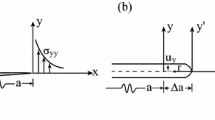Summary
A plane strain problem for a crack with a frictionless contact zone at the leading crack tip expanding stationary along the interface of two anisotropic half-spaces with a subsonic speed under the action of various loadings is considered. The cases of finite and infinite-length interface cracks under the action of a moving concentrated loading at its faces are considered. A finite-length crack for a uniform mixed-mode loading at infinity is considered as well. The associated combined Dirichlet-Riemann boundary value problems are formulated and solved exactly for all above-mentioned cases. The expressions for stresses and the derivatives of the displacement jumps at the interface are presented in a closed analytical form for an arbitrary contact zone length. Transcendental equations are obtained for the determination of the real contact zone length, and the associated closed form asymptotic formulas are found for small values of this parameter. It is found that independently of the types of the crack and loading, an increase of the crack tip speed leads to an increase of the real contact zone length and the correspondent stress intensity factor. The latter increase significantly for an interface crack tip speed approaching the Ragleigh wave speed.
Similar content being viewed by others

References
Gol'dshtein, R.V.: On the steady motion of a crack along a straight line boundary between two joined materials [in Russian]. Mechanika Tverdogo Tela 1 (1966) 94–102
Willis, J.R.: Fracture mechanics of interfacial cracks. J Mech Physics Solids 19 (1971) 353–368
Atkinson, C.: Dynamic crack problems in dissimilar media. In: G.C. Sih (ed) Mechanics of Fracture 4. Noordhoff International Publishing, Leyden (1977) pp. 213–248.
Lekhnitskii, S.G. Theory of elasticity of an anisotropic elastic body. San-Francisco: Holden-Day, 1963
Eshelby, J.D.;Read, W.T.;Shockley, W.: Anisotropic elasticity with application to dislocation theory. Acta Metall 1 (1953) 251–259
Stroh, A.N.: Dislocations and cracks in anisotropic elasticity. Phil Mag 7 (1958) 625–646
Wu, K.C.: Explicit crack tip fields of an extending interface crack in an anisotropic bimaterial. Int J Solids Struct 27 (1991) 455–466
Yang, W.;Suo, Z.;Shih, C.F: Mechanics of dynamic debonding. Proc. R. Soc Lond A 433 (1991) 679–697
Yoffe, E.: The moving Griffith crack. Phil Mag 42 (1951) 739–750
Herrmann, K.P.;Noe, A.: Analysis of quasi-static and dynamic interface crack extension by the method of caustics. Engineering Fracture Mechanics 42 (1992) 573–588
Herrmann, K.P.;Noe, A.: (1993) Analysis of dynamic mixed-mode stress fields in bimaterials by the method of caustics. Theo. Appl. Fracture Mech 19 (1993) 49–59
Herrmann, K.P.;Noe, A.: Dynamic interface crack propagation and related problems of caustics. Arch Mech 47 (1995) 915–956
Noe, A.;Herrmann, K.P.: Elastodynamic parameters for dynamic interface fracture mechanics. Acta Mechanica 123 (1997) 203–226
Williams, M.L.: The stresses around a fault or cracks in dissimilar media. Bull Seismol Sos Am 49 (1959) 199–204
Comninou, M. The interface crack. J Appl Mech 44 (1977) 631–636
Simonov, I.V.: The interface crack in a homogeneous field of stresses [in Russian]. Mech Comp Materials (1985) 969–976
Dundurs, J.;Gautesen, A.K.: An opportunistic analysis of the interface crack. Int J Fracture 36 (1988) 151–159
Loboda, V.V.: The quasi-invariant in the theory of interface cracks. Engng Fracture Mech 44 (1993) 573–580
Herrmann, K.P.;Loboda, V.V.: On interface crack models with contact zones situated in an anisotropic bimaterial. Archive of Applied Mechanics 69 (1999) 317–335
Simonov, I.V.: Dynamics of the tear-shear crack at the interface of two elastic materials. Reports of the Academy of Science of USSR [in Russian] 271 (1983) 65–68
Nakhmejn, E.L.;Nuller, B.M.: Dynamic contact problems for an orthotropic elastic half- plane and a bimaterial plane. Prikladnaja Matematika i mechanika [in Russian] 54 (1990) 633–641
Huang, Y.;Wang, W.;Liu, C.;Rosakis, A.J.: Intersonic crack growth in bimaterial interfaces: An investigation of crack face contact. J Mech Physics Solids 46 (1998) 2233–2259
Herrmann, K.P.;Loboda, V.V.: Contact zone models for an interface crack in a thermomechanically loaded anisotropic bimaterial. J Thermal Stresses 24 (2001) 479–506
Muskhelishvili, N.I.: Some Basic Problems of the Mathematical Theory of Elasticity Leyden: Noordhoff International Publishing, 1977
Gakhov, F.D.: Boundary Value Problems. Oxford: Pergamon Press, 1966
Author information
Authors and Affiliations
Corresponding author
Rights and permissions
About this article
Cite this article
Herrmann, K.P., Loboda, V.V. & Komarov, A.V. Contact zone assessment for a fast growing interface crack in an anisotropic bimaterial. Arch. Appl. Mech. 74, 118–129 (2004). https://doi.org/10.1007/BF02637213
Received:
Accepted:
Issue Date:
DOI: https://doi.org/10.1007/BF02637213



